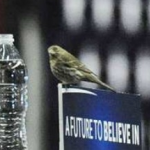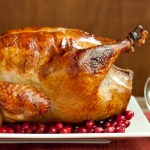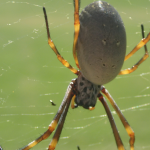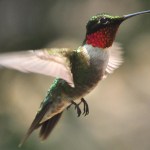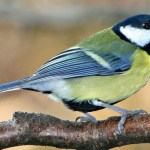bird
The #3 post so far this year explored how zebra finches reward themselves for singing well:
Dopamine is an important hormone released from neurons involved in reward pathways. Researchers at Cornell University wanted to know if dopamine signaling was involved in how birds learn songs. Their findings, recently published in Science, present evidence that neurons in the brain of zebra finches do in fact decrease dopamine signals when the birds hear an error in their song in comparison to when they sing 'correctly'. The researchers also found that dopamine signaling was enhanced when…
Sara Letzner had humans compete against pigeons in a behavioural experiment. Photo from: Ruhr-Universitat at Bochum
A new study conducted by Drs. Sara Letzner and Onur Gunturkun (Ruhr-Universitat at Bochum) as well as Dr. Christian Beste (Technische Univeritat at Dresden) shows that pigeons are better than humans when it comes to multitasking. Their findings were published in Current Biology.
The findings from the study show that the mammalian cerebral cortex, with all of its cortical layers, is not the only type of brain that can perform complex tasks as birds do not have a…
Image of a variety of bird eggs from Internet Archive Book Images, via Wikimedia Commons
Ever wonder why bird eggs are shaped the way they are and what drives the variations in egg shapes across species? I never really wondered that either until I saw an article in Science that explained a possible reason...then I just HAD to know. Some theories had been proposed suggesting that their shape prevented eggs from rolling out of nests or otherwise sustaining damage, and so on. According to the new study, the shape of a bird's eggs may be related to their ability to fly…
I LOVE THIS MEETING!
DAY 3 included several very interesting comparative physiology sessions.
Image of birds from Wikipedia
Eldon Braun (University of Arizona) spoke about how birds have a unique way to prevent water loss and thereby dehydration. In mammals, the kidneys are responsible for recovering water from the urine. However when birds are well-hydrated, the urine enters the colon and moves backwards up the gastrointestinal tract to facilitate water reabsorption prior to voiding the urine.
Hiroko Nishimura (The University of Tennessee) spoke about work she had done over the years…
You all know this happened.
But there is some controversy over what kind of bird it is.
There is no doubt whatsoever that the bird was a finch. However, what kind? Most likely a house finch, because they are common, and the most likely to live in a big auditorium thingie and not be fearful of people.
A pic of the bird is above. Here is another:
What do you think it is?
I came across this neat video summarizing a study that found some birds build nests near alligators to protect themselves from other predators. But the protection is not without a price.
A special thank you to reader Dr. Barbara Goodman, Professor of Physiology at Sanford School of Medicine of the University of South Dakota who sent me a story from The Scientist about sleep in animals complete with footage of a dolphin that was seen apparently "sleeping" (video posted on YouTube):
Why do animals sleep? This is a question with many potential answers. It is known that birds and mammals experience slow-wave and rapid eye movement (REM) sleep patterns. During the first pattern, slow waves with high amplitudes can be seen if measuring electrical…
Canadian Geese. Image take near Lakeview, OR. Image from: Bureau of Land Management
A new study conducted by researchers Eric Vaillancourt and Jean-Michel Weber at the University of Ottawa examined blood sugar regulation in a bird that specialize in long distance migration, the Canada goose (Branta canadensis, image above). As referenced in the study published in the American Journal of Physiology - Regulatory, Integrative and Comparative Physiology, Canadian geese migrate approximately 7,000 km on their way to the Arctic, a trip that includes non-stop flights of up to…
Image from www.chow.com
Did you know that the typical Thanksgiving day broad-breasted white turkey develops in as little as 136 days (on average)? This remarkably quick development is a result of years of selective breeding. The average turkey in 1929 was only about 13 pounds, whereas modern turkeys average around 30 pounds with much of the weight centered in the breast muscles.
The Poultry Science Association claims that this breeding program has resulted in skeletal problems as muscle growth outpaces bone growth, heart problems, and a lower ability to mount immune responses to…
Image from the American Physiological Society's website.http://www.the-aps.org/mm/Conferences/APS-Conferences/2014-Conferences/…
Tuesday was no less exciting than Monday!
Here are some highlights:
I thoroughly enjoyed a session called "Overcoming a Major Physiological Barrier: Adaptation from Saline to Freshwater Habitats" which highlighted the need for several species to shift how they regulate ion balance when they migrate between fresh water (ion absorption from the water) and salt water (ion secretion to the water).
Clements K, Bojarski L, Johnson K, McMillan S, White L, Angert E (Univ…
Image from the American Physiological Society's website.http://www.the-aps.org/mm/Conferences/APS-Conferences/2014-Conferences/…
I am really excited about the comparative physiology conference that starts this weekend in San Diego! Here is a press release about the meeting (author Stacy Brooks from the American Physiological Society):
Bethesda, Md. (September 25, 2014) — More than 400 comparative and evolutionary physiologists will gather to present new research and discoveries in animal physiology at the American Physiological Society’s 2014 intersociety meeting “Comparative…
A new study from researchers at the University of Sydney shows that golden orb-weaving spiders (Nephila plumipes) that live in the city are larger and produce more offspring as compared to country living.
When they say the spiders are big, they mean really big. The females can reach up to 20-25mm (males are only ~5mm).
Image from Spiders of Australia http://ednieuw.home.xs4all.nl/australian/nephila/Nephila.html
The researchers speculate that the urban heat island effect, which is attributed to a lack vegetation and hard surfaces, may lead to the increased body size as invertebrates in…
Brandy Velten (doctoral student) and Dr. Kenneth Welch (Comparative Physiologist) from the University of Toronto wanted to know whether birds with very different speeds at which they flaps their wings (i.e. wingbeat frequencies) had correspondingly varying types of myosin proteins in their muscles. Their findings were published in the American Journal of Physiology last month.
In their study they compared ruby-throated hummingbirds and zebra finches which reportedly have some of the highest wingbeat frequencies (20-60Hz). As you can imagine, their flight muscles are made up of almost…
Here is a neat video that I watched at the David Bruce Undergraduate Poster session at the Experimental Biology conference last week. It describes the amazing physiology of the avian lung and was created by an undergraduate student researcher, Peter Luu for the Physiology Video Contest sponsored by the American Physiological Society. This video won the Viewer's Choice Award:
To see more of the submitted videos, visit the American Physiological Society website.
I came across this interesting video today from Animal Wire that shows a population of catfish caught hunting pigeons on land:
Who knew that catfish had more in common with cats than just their whiskers.
New research provides more evidence of how birds conserve energy by flying in a "V" formation:
Clip Art from www.LeeHanson.com
Just in time for Halloween:
Besides being an excellent way to avoid predators, roosting or hanging upside down is optimal for taking off into flight. Bats are not able to launch into flight from an upright position because their wings do not generate sufficient lift while at a dead stop. Additionally, their hindlegs are rather underdeveloped, so they are not able to run to generate lift for take-off. Instead, bats essentially fall into flight.
Learn more in this video comparing flight mechanics in bats and birds:
Source:
Animal Plant
An article came out today in Wunderground.com about an iconic bird (in both good and bad ways) in South Africa, the Hadeda Ibis (Bostrychia hagedash). There are stores named after the birds, songs dedicated to them and even a documentary called "Hadeda Sunrise" that you can watch here:
Image of male great tit from BBC Nature News.
A new study published in Ecology Letters suggests that shy male great tits build stronger bonds with birds in their own flock. This population of birds has been studied in Wytham Woods, near Oxford, UK since 1947.
In case you are wondering, the team determined "shyness" and "boldness" by capturing birds and placing them in a novel environment for 10 minutes. Shy birds were slow to explore the new environment whereas bold birds explored it quickly. The birds were then tagged and tracked using radio transmitters. The researchers…
Image from www.123rf.com
A new study published in the American Journal of Physiology presents data suggesting that birds do not carry a specific anti-inflammatory protein critical for keeping inflammation under control in mammals, reptiles and amphibians.
The specific protein is tristetraprolin (TTP). It functions mainly by inhibiting key mediators of inflammation in the body, such as tumor necrosis factor alpha (TNFa). In fact, mice that are missing this protein have chronic systemic inflammation from unchecked TNFa. Moreover, mice missing the protein specifically in myeloid cells develop…
